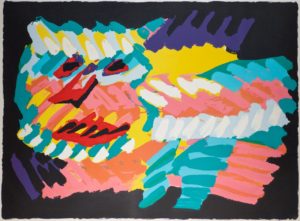What Is the CoBrA Art Movement?

“Pink Cat” Appel hand-signed Limited Edition Lithograph Print
The CoBrA art movement was part of the 20th-century art movement with its own twist. Breaking away from the rest, this group of international artists forged a unique mark in the 20th-century art world that has continued to last as a significant statement on life and art methodology.
Where Does “CoBrA” Come From?
The name CoBrA comes from the three cities from which the founders of the movement came (Copenhagen, Brussels, Amsterdam). These founders were Karel Appel, Corneille, Christian Dotrement, Asger Jorn, Joseph Noiret, and Constant Nieuwenhuys. In 1948, these artists from Copenhagen, Brussels, and Amsterdam came together under the bond of similar ideas concerning philosophy, the need for action, and experimentation in creating art.
The Principles of the CoBrA Art Movement
The art principles of the CoBrA art movement adhere to a sense of exploration and going back to one’s roots. Their principles were as follows:
- Experimentation
- Spontaneity
- Creation over theory
- Art with roots
- Material rooted in material
The Methods of the CoBrA Art Movement
Many art experts often describe their work as being rebellious, aggressive, ruthless, and even violent. Their expressions take inspiration from the artwork of children, the mentally handicapped, tribal nations, and primitive artifacts. Aside from these inspirations, their work aimed to be experimental and full of variety. Each of the CoBrA artists had their own mark on this avant-garde style, some having darker or brighter colors or more or less traditional designs.
The Rise and Fall of CoBrA
CoBrA lasted from 1948 to 1951, but although it was short-lived, it made a notable impact on the international art scene. At an international conference on Surrealism, Christian Dotrement of Belgium broke away from surrealist art theory and found like minds with the other CoBrA founders. Armed with Marxist ideals, they believed that art should aim for social action rather than dwell in the theoretical like surrealist art did.
The artists created a magazine, books, murals, and exhibits and had two major exhibits that heightened their career. In 1949, Willem Sandberg took an interest in their art and held an exhibit for them at the Amsterdam Stedelijk Museum. Their second exhibition at the Palais des Beaux-Arts brought them into the establishment of the contemporary art world, thus ending their avant-garde status.
Contact Zimmerman Fine Art Today!
Since 1979 Zimmerman Editions Ltd. has worked closely with many internationally acclaimed artists to execute editions of their most unique images. Collaborating directly with the artists, Zimmerman Editions’ atelier has printed, fabricated, and published many special limited editions of fine art, including both prints and sculptures. All images have been faithfully produced to meet the artists’ most exacting requirements. Many of these high-quality art prints and objets d’art are represented in public and private collections around the world.
If you are a fine art dealer or marketer, or interested in collecting contemporary fine art, contact us today through our short form or our number at 888-484-1850. For more about fine art, keep in touch through Facebook, Twitter, and LinkedIn!
